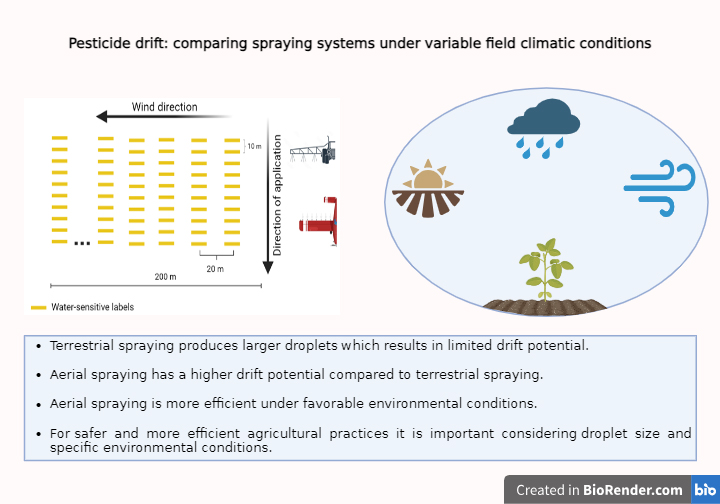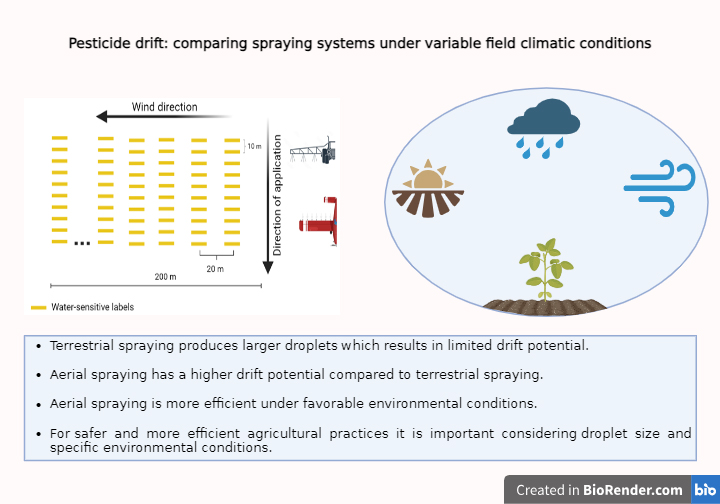Pesticide drift: comparing spraying systems under variable field climatic conditions
DOI:
https://doi.org/10.48162/rev.39.156Keywords:
aerial application, terrestrial spraying, application technologyAbstract

Safe pesticide application must ensure efficacy in pest control while minimizing environmental and human health risks. This study investigated pesticide potential drift by comparing ground and aerial spraying systems under different climatic conditions. The research was conducted in Rio Verde, Goiás, Brazil, using a randomized block experimental design with 10 repetitions and a 2 x 2 split-plot scheme, considering spraying systems and climatic conditions as factors. Favorable and Unfavorable conditions were determined by relative air humidity, temperature, and wind speed. Aerial spraying was performed using a Cessna aircraft, while terrestrial spraying was done using a self-propelled Montana Parruda sprayer. Variables assessed included Volumetric Median Diameter (VMD), droplet density (DEN), and target coverage. Results revealed that aerial spraying has a higher drift potential, exceeding 180 m, compared to terrestrial spraying, limited to 90 m under unfavorable conditions. Although terrestrial spraying produces larger droplets, its shorter distance to the target and reduced speed minimize lateral movement, limiting drift potential. Droplet density and non-target area coverage were low for both systems, (0.1%). Under ideal conditions, aerial spraying is more efficient, but both methods require rigorous safety measures to prevent contamination risks. This study underlines the importance of considering droplet size and specific environmental conditions when choosing a spraying system, contributing to safer and more efficient agricultural practices.
Highlights:
- Terrestrial spraying produces larger droplets which results in limited drift potential.
- Aerial spraying has a higher drift potential compared to terrestrial spraying.
- Aerial spraying is more efficient under favorable environmental conditions.
- For safer and more efficient agricultural practices it is important considering droplet size and specific environmental conditions.
Downloads
References
Antuniassi, U. R.; Baio, F. H. R. 2008. Tecnologia de aplicação de defensivos. In.: Vargas, L.; Roman, E. S. Manual de manejo e controle de plantas daninhas. Passo Fundo: Embrapa Trigo. 173-212.
Baio, F. H. R.; Antuniassi, U. R.; Castilho, B. R.; Teodoro, P. E.; Silva, E. E. D. 2019. Factors affecting aerial spray drift in the Brazilian Cerrado. PLoS One. 14(2): e0212289.
Bish, M.; Oseland, E.; Bradley, K. 2021. Off-target pesticide movement: a review of our current understanding of drift due to inversions and secondary movement. Weed Technology. 35(3): 345-356.
Burin, F.; Alves de Souza, C. M.; Ramires, I.; da Silva, P. V. 2022. Physical-chemical properties of spray syrup in tank-mixing multiple pesticides and water sources used in grain farming. Revista de la Facultad de Ciencias Agrarias. Universidad Nacional de Cuyo. Mendoza. Argentina. 54(1): 132-144. DOI: https://doi.org/10.48162/rev.39.072
European Commission. Eurostat Database. Pesticide Sales. 2016. http://appsso.eurostat.ec.europa.eu/nui/show.do?dataset=aei_fm_salpest09&lang=en (Accessed in: 2023-Oct-30).
Ferguson, J. C.; O’Donnell, C. C.; Chauhan, B. S.; Adkins, S. W.; Kruger, G. R.; Wang, R.; Hewitt, A. J. 2015. Determining the uniformity and consistency of droplet size across spray drift reducing nozzles in a wind tunnel. Crop Protection. 76(10): 1-6.
Ferreira, D. F. 2019. SISVAR: a computer analysis system to fixed effects split plot type designs. Brazilian Journal of Biometrics. 37(4): 529-535.
Food and Agriculture Organization of the United Nations. FAOSTAT database. Pesticides use. 2016. http://www.fao.org/faostat/em/#data/RP (Accessed in: 2023- Oct-30).
Gelain, I. O. 2020. A regulação do agrotóxico e seu impacto na produção vitivinícola no Rio Grande do Sul. https://repositorio.unisc.br/jspui/handle/11624/3034 (Accessed in: 2023- Oct-30).
Gentil-Sergent, C.; Basset-Mens, C.; Gaab, J.; Mottes, C.; Melero, C.; Fantke, P. 2021. Quantifying pesticide emission fractions for tropical conditions. Chemosphere. 275(15): 130014.
Gil, E.; Balsari, P.; Gallart, M.; Llorens, J.; Marucco, P.; Andersen, P. G.; Llop, J. 2014. Determination of drift potential of different flat fan nozzles on a bar sprayer using a test bench. Crop protection. 56(2): 58-68.
Grella, M.; Miranda-Fuentes, A.; Marucco, P.; Balsari, P. 2020. Field assessment of a newly-designed pneumatic spout to contain spray drift in vineyards: evaluation of canopy distribution and off-target losses. Pest Management Science. 76(12): 4173-4191.
Interfase. CIR 1.5: Software para análisis de espectro de pulverización. 2023. http://www.interfasetres.com.ar/producto/pulverizacion/software-cir15 (Accessed in: 2023- Oct-30).
Jacquet, F.; Jeuffroy, M. H.; Jouan, J.; Le Cadre, E.; Litrico, I.; Malausa, T.; Reboud, X.; Huyghe, C. 2022. Pesticide-free agriculture as a new paradigm for research. Agronomy for Sustainable Development. 42(8): 1-24.
Jones, G. T.; Norsworthy, J. K.; Barber, T. 2019. Off-target movement of diglycolamine dicamba to non-dicamba soybean using practices to minimize primary drift. Weed Technology. 33(1): 24-40.
Lykogianni, M.; Bempelou, E.; Karamaouna, F.; Aliferis, K. A. 2021. Do pesticides promote or hinder sustainability in agriculture? The challenge of sustainable use of pesticides in modern agriculture. Science of the Total Environment. 795(11): 148625.
Mello, C. E.; do Carmo, E. L.; Braz, G. B.; Procópio, S. D. O.; Simon, G. A.; Souza, M. D. F.; Araújo, G. E. S.; Lins, H. A. 2024. Application rate and nozzles associated with droplet electrification affect the spraying quality in common bean. Brazilian Journal of Agricultural and Environmental Engineering. 28(2): e273814.
Musiu, E. M.; Qi, L.; Wu, Y. 2019. Spray deposition and distribution on the targets and losses to the ground as affected by application volume rate, airflow rate and target position. Crop Protection. 116(2): 170-180.
Nascimento, E.; Zago, A. 2013. Agricultural plane flies over school and poisons dozens of children, in
GO. https://g1.globo.com/goias/noticia/2013/05/aviao-agricolasobrevoa-escola-e-intoxica-dezenas-de-criancas-em-go.html (Accessed in: 2023-Oct-30).
Nuyttens, D.; Zwertvaegher, I. K.; Dekeyser, D. 2017. Spray drift assessment of different application techniques using a drift test bench and comparison with other assessment methods. Biosystems Engineering. 154(2): 14-24.
Oseland, E.; Bish, M.; Steckel, L.; Bradley, K. 2020. Identification of environmental factors that influence the likelihood of off-target movement of dicamba. Pest Management Science. 76(9): 3282-3291.
Sabzevari, S.; Hofman, J. 2022. A worldwide review of currently used pesticides’ monitoring in agricultural soils. Science of The Total Environment. 812(3): 152344.
Thornthwaite, C. W. 1948. An approach toward a rational classification of climate. Geographical Review. 38(1): 55-94.
Uçkun, A. A; Öz, Ö. B. 2021. Evaluation of the acute toxic effect of azoxystrobin on non-target crayfish (Astacus leptodactylus Eschscholtz, 1823) by using oxidative stress enzymes, ATPases and cholinesterase as biomarkers. Drug and Chemical Toxicology. 44(5): 550-557.
US Geological Survey. 2016. USGS NAWQA: The pesticide National Synthesis Project. Estimated annual agricultural pesticide use. https://water.usgs.gov/nawqa/pnsp/usage/maps/county-level/ (Accessed in: 2023-Oct-30).

Published
How to Cite
Issue
Section
License
Copyright (c) 2018 Revista de la Facultad de Ciencias Agrarias UNCuyo

This work is licensed under a Creative Commons Attribution-NonCommercial-ShareAlike 3.0 Unported License.
Aquellos autores/as que tengan publicaciones con esta revista, aceptan las Políticas Editoriales.










.jpg)




